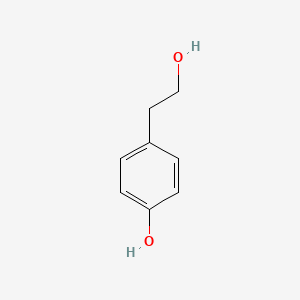

1. 2-(4-hydroxyphenyl)ethyl Acetate
2. 4-hydroxybenzeneethanol
3. 4-hydroxyphenylethanol
4. Beta-(4-hydroxyphenyl)ethanol
5. N-tyrosol
6. P-hydroxyphenylethanol
7. P-tyrosol
8. Para-hydroxyphenylethanol
9. Tyrosol
10. Tyrosol Acetate
1. Tyrosol
2. 501-94-0
3. 4-hydroxyphenethyl Alcohol
4. 4-(2-hydroxyethyl)phenol
5. 4-hydroxyphenylethanol
6. 4-hydroxybenzeneethanol
7. P-hydroxyphenethyl Alcohol
8. Benzeneethanol, 4-hydroxy-
9. P-tyrosol
10. 4-hydroxyphenylethyl Alcohol
11. 2-(4-hydroxyphenyl)ethyl Alcohol
12. P-thyrosol
13. Mfcd00002902
14. Nsc 59876
15. 2-(p-hydroxyphenyl)ethanol
16. Metoprolol Impurity 07
17. 4-hydroxy-benzeneethanol
18. 1ak4mu3snx
19. P-hydroxyphenylethyl Alcohol
20. 4-(2-hydroxy-ethyl)-phenol
21. Chembl53566
22. Chebi:1879
23. Nsc-59876
24. P-hydroxyphenylethanol
25. Tyrosol C
26. Smr000857159
27. P-hpea
28. 4-hydroxyphenethylalcohol
29. Einecs 207-930-8
30. Unii-1ak4mu3snx
31. Beta-(4-hydroxyphenyl)ethanol
32. 4-tyrosol
33. Yrl
34. Tyrosol ,(s)
35. 4-hydroxybenzenethanol
36. 4-(hydroxyethyl)phenol
37. P-hydroxy-benzeneethanol
38. Tyrosol [mi]
39. B-(p-hydroxyphenyl)ethanol
40. Bmse000173
41. B-(4-hydroxyphenyl)ethanol
42. 4-hydroxyphenylmethylcarbinol
43. 2-(p-hydroxyphenyl) Ethanol
44. Schembl43838
45. (4-hydroxyphenethyl) Alcohol
46. 2-(4-hydroxyphenyl) Ethanol
47. 2-(4-hydroxyphenyl)-ethanol
48. Beta-(p-hydroxyphenyl)ethanol
49. Mls001332423
50. Mls001332424
51. Phenethyl Alcohol, P-hydroxy-
52. Ethanol, 2-(4-hydroxyphenyl)
53. Dtxsid8060111
54. Schembl10620528
55. .beta.-(p-hydroxyphenyl)ethanol
56. 2-(4-hydroxyphenyl)-1-ethanol
57. Ethanol, 2-(4-hydroxyphenyl)-
58. .beta.-(4-hydroxyphenyl)ethanol
59. Hms2230e12
60. Zinc164581
61. 2-(4-hydroxyphenyl)ethanol, 98%
62. Bcp34277
63. Hy-n0474
64. Nsc59876
65. Str02735
66. Hydroxyphenethyl Alcohol, P-
67. Bdbm50339585
68. S3773
69. Akos000280287
70. Ac-2493
71. Ccg-266147
72. Cs-w019782
73. Ks-5274
74. Ncgc00246994-01
75. Sy001653
76. Db-019455
77. Am20060146
78. Ft-0608647
79. H0720
80. N1496
81. A14486
82. C06044
83. 2-(4-hydroxyphenyl)ethanol, Analytical Standard
84. Nsc 59876; P-hpea;4-hydroxyphenethyl Alcohol
85. Q402607
86. Metoprolol Tartrate Impurity G [ep Impurity]
87. Metoprolol Succinate Impurity G [ep Impurity]
88. Tyrosol (constituent Of Rhodiola Rosea) [dsc]
89. F0001-1309
90. 947d0361-23c6-4863-8346-22ab05108ac5
91. 4-hydroxy-benzeneethanol;4-hydroxyphenylethanol;beta-(4-hydroxyphenyl)ethanol
| Molecular Weight | 138.16 g/mol |
|---|---|
| Molecular Formula | C8H10O2 |
| XLogP3 | 0.4 |
| Hydrogen Bond Donor Count | 2 |
| Hydrogen Bond Acceptor Count | 2 |
| Rotatable Bond Count | 2 |
| Exact Mass | 138.068079557 g/mol |
| Monoisotopic Mass | 138.068079557 g/mol |
| Topological Polar Surface Area | 40.5 Ų |
| Heavy Atom Count | 10 |
| Formal Charge | 0 |
| Complexity | 85.3 |
| Isotope Atom Count | 0 |
| Defined Atom Stereocenter Count | 0 |
| Undefined Atom Stereocenter Count | 0 |
| Defined Bond Stereocenter Count | 0 |
| Undefined Bond Stereocenter Count | 0 |
| Covalently Bonded Unit Count | 1 |
Anti-Arrhythmia Agents
Agents used for the treatment or prevention of cardiac arrhythmias. They may affect the polarization-repolarization phase of the action potential, its excitability or refractoriness, or impulse conduction or membrane responsiveness within cardiac fibers. Anti-arrhythmia agents are often classed into four main groups according to their mechanism of action: sodium channel blockade, beta-adrenergic blockade, repolarization prolongation, or calcium channel blockade. (See all compounds classified as Anti-Arrhythmia Agents.)
Antioxidants
Naturally occurring or synthetic substances that inhibit or retard oxidation reactions. They counteract the damaging effects of oxidation in animal tissues. (See all compounds classified as Antioxidants.)
BUILDING BLOCK

CAS Number : 501-94-0
End Use API :
End Use API : 2-(4-Hydroxyphenyl)Ethanol
About the Company : We are into manufacturing of bulk drug Intermediates and Active Pharmaceutical Ingredients (API). Our core competence is contract manufacturing for our clients who are looking for manuf...

